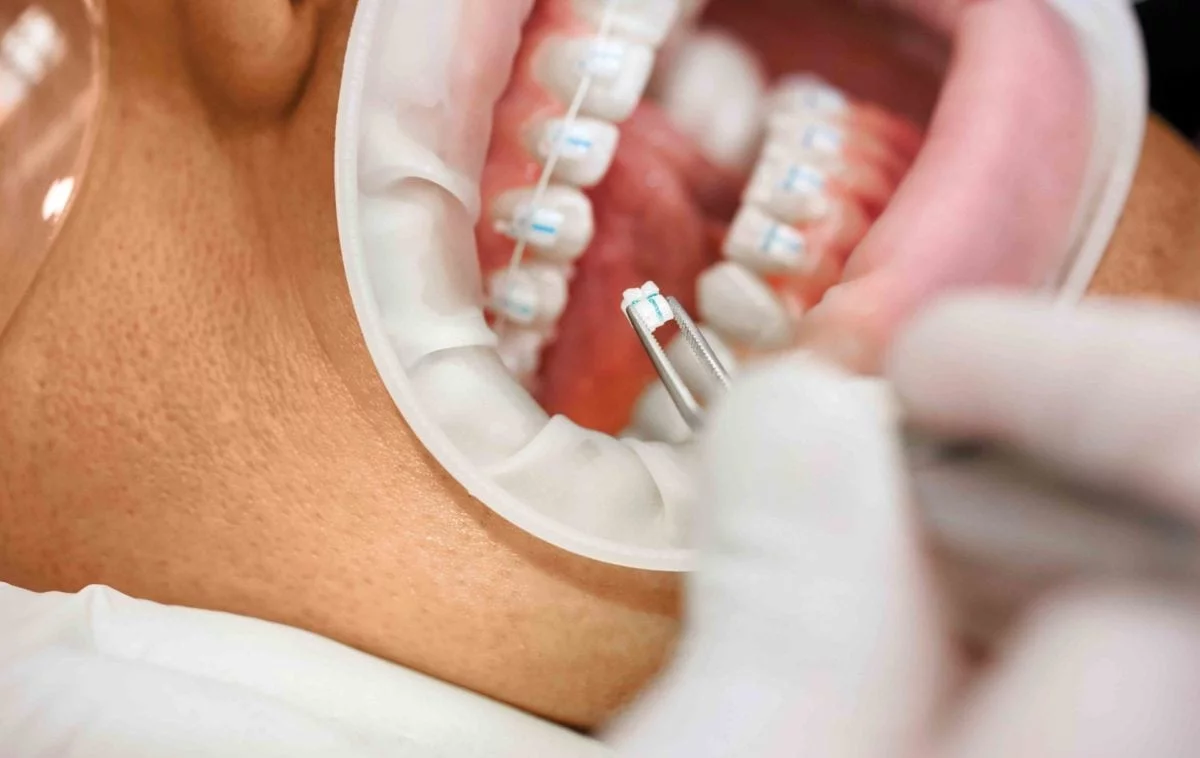Health
Bonding Challenges with Ceramic Brackets: Solutions and Innovations

Ceramic brackets offer a more aesthetic alternative to metal braces but come with unique bonding challenges that can affect treatment outcomes, efficiency, and patient satisfaction. This guide explores common issues like bracket debonding and provides evidence-based solutions, including material innovations and advanced techniques, to help orthodontic practitioners optimize their ceramic bracket protocols while preserving their aesthetic appeal.
Common Issues Encountered
Bond Strength Variations
Ceramic brackets typically exhibit different bond strengths compared to their metal counterparts. The crystalline structure of ceramic materials can create inconsistencies in surface texture, leading to variable adhesion patterns. Some areas of the bracket base may bond more effectively than others, creating weak points that can compromise overall bracket retention.
Temperature sensitivity also plays a significant role in bonding variability. Ceramic materials expand and contract differently than tooth enamel, which can create stress at the bracket-adhesive interface during temperature changes in the oral environment.
Debonding Complications
While ceramic brackets are designed to debond cleanly, the reality is often more complex. Adhesive remnants frequently remain on the tooth surface after bracket removal, requiring additional time for cleanup. In some cases, the ceramic material itself may fracture during debonding, leaving fragments that must be carefully removed.
The increased bond strength of some ceramic bracket systems, while beneficial during treatment, can make controlled debonding more challenging. This paradox requires orthodontists to balance retention needs with efficient removal procedures.
Bracket Fracture
Ceramic brackets are inherently more brittle than metal alternatives. Excessive force during bonding procedures can create microcracks that may not be immediately visible but can lead to bracket failure under normal orthodontic forces. These fractures often occur at stress concentration points around tie-wing areas or where archwires contact the bracket slot.
Advancements in Bonding Materials
Next-Generation Adhesives
Modern adhesive systems have evolved significantly to address ceramic bracket bonding challenges. Light-cured composites now offer improved flow characteristics and enhanced bond strength specifically formulated for ceramic applications. These materials provide better wetting of ceramic surfaces and create more uniform stress distribution.
Dual-cure adhesives represent another advancement, combining the convenience of light activation with chemical curing in areas where light penetration may be limited. This technology ensures complete polymerization even in posterior regions where access can be challenging.
Primer Innovations
Specialized primers designed for ceramic brackets have emerged as game-changers in bonding protocols. These primers contain coupling agents that create stronger chemical bonds between the ceramic surface and adhesive resin. Silane-based primers, in particular, have shown significant improvements in bond strength and durability.
Some newer primer formulations incorporate nano-particles that fill microscopic irregularities in ceramic surfaces, creating more uniform bonding substrates. This technology helps address the surface texture variations that can compromise bond reliability.
Techniques to Improve Bonding Success
Surface Preparation Protocols
Proper surface preparation remains fundamental to successful ceramic bracket bonding. Sandblasting with aluminum oxide particles creates mechanical retention while removing any surface contaminants. The optimal particle size and pressure settings vary depending on the specific ceramic bracket system being used.
Hydrofluoric acid etching, when used judiciously, can enhance surface roughness for improved mechanical retention. However, this technique requires careful application and safety protocols due to the caustic nature of the etching solution.
Moisture Control Strategies
Saliva contamination represents one of the most significant threats to successful ceramic bracket bonding. Advanced isolation techniques, including rubber dam application and high-volume suction, create optimal bonding conditions. Some practitioners have adopted pneumatic isolation systems that provide superior moisture control while improving patient comfort.
The use of bonding accelerators can also help overcome minor moisture contamination issues by promoting rapid initial cure in the presence of trace humidity.
Force Application Methods
The method and magnitude of force application during bracket placement significantly affects bonding outcomes. Consistent, controlled pressure ensures uniform adhesive thickness and eliminates air bubbles that can compromise bond integrity. Digital pressure gauges help standardize force application across different operators and clinical scenarios.
Vibratory bonding instruments have shown promise in improving adhesive flow and reducing void formation. These devices use controlled vibrations to enhance intimate contact between the bracket base and prepared enamel surface.
The Role of Indirect Bonding Orthodontics
Indirect bonding has emerged as a valuable technique for improving ceramic bracket placement accuracy and bonding consistency. This approach allows for precise bracket positioning using laboratory models while reducing chair time and improving patient comfort.
The indirect bonding process enables orthodontists to achieve optimal bracket placement under controlled conditions, free from the constraints of intraoral access and patient cooperation. Transfer trays ensure accurate reproduction of planned bracket positions while maintaining proper bonding protocols.
Advanced orthodontic computer software now integrates with indirect bonding workflows, allowing for digital treatment planning and virtual bracket placement. This technology enhances precision while streamlining the overall bonding process.
Custom transfer trays fabricated using 3D printing technology provide superior fit and retention compared to traditional vacuum-formed alternatives. These precision trays ensure accurate bracket transfer while maintaining optimal adhesive thickness.
Future Trends in Ceramic Bracket Bonding
Smart Adhesive Systems
Emerging adhesive technologies incorporate responsive polymers that adapt to oral environmental changes. These smart materials can modify their properties based on temperature, pH, or mechanical stress, potentially reducing bracket failure rates.
Self-etching adhesive systems eliminate separate etching steps while providing reliable bond strength. These simplified protocols reduce technique sensitivity while maintaining clinical effectiveness.
Nanotechnology Applications
Nanoparticle-enhanced adhesives offer improved mechanical properties and enhanced biocompatibility. These materials provide superior wear resistance and reduced bacterial adhesion, potentially improving long-term outcomes.
Carbon nanotube reinforcement shows promise for creating stronger, more flexible adhesive bonds that better accommodate the different expansion coefficients of ceramic and enamel.
Digital Integration
Artificial intelligence algorithms are being developed to predict bonding success based on individual patient factors. These systems could help orthodontists customize bonding protocols for optimal outcomes in challenging cases.
Real-time monitoring systems may eventually provide feedback during the bonding process, alerting practitioners to potential issues before bracket placement is completed.
Conclusion
Effective ceramic bracket bonding requires advanced materials, refined techniques, and careful clinical attention. By adopting evidence-based strategies and staying updated on the latest innovations, orthodontists can improve outcomes while preserving aesthetics. As bonding technology evolves, it offers new possibilities to overcome challenges and enhance patient care.
Health
Key Operational Improvements Shown Across Multiple Human Services Case Studies

“We thought we were doing okay… until we saw what was possible.”
That’s the kind of quiet realization you’ll hear from human services leaders after a tech upgrade. Not because their old system was broken—but because they didn’t realize how much time, clarity, and impact they were leaving on the table.
Across the country, organizations serving vulnerable populations—from youth and families to those experiencing homelessness—are seeing measurable gains by modernizing their workflows. Not hypotheticals. Not vague “digital transformation” jargon.
We’re talking about documented, real-world operational improvements, the kind highlighted in Casebook case studies, where human services teams have streamlined processes, reduced duplication, and radically improved data visibility.
Let’s break down some of the standout shifts.
1. Intake Time Cut by More Than 50%
You know what intake looks like at most orgs: three forms, two internal emails, a paper folder, and a spreadsheet waiting for someone to “get to it.”
Multiple Casebook case studies show how implementing a digital intake process—customized to reflect the organization’s own language and logic—has slashed average onboarding times.
In one agency, the time required to complete an initial intake dropped from 45 minutes to under 20. That means less time duplicating data and more time focused on clients who need support now, not tomorrow.
2. Real-Time Reporting Replaces Monthly Headaches
How many hours a month does your staff spend scrambling for reports that make sense of scattered data?
In one Casebook example, a nonprofit supporting at-risk youth moved from manually compiling quarterly reports to automated dashboards that updated in real time. The result? Not only faster grant reporting—but more strategic decision-making throughout the month.
Because when your case management system includes real-time metrics on service delivery, referrals, and outcomes, you don’t just hope your programs are working. You know they are—and can prove it.
3. Cross-Department Collaboration Finally Becomes… Possible
One of the biggest operational bottlenecks in human services? Communication silos.
A housing team might not know what mental health services were provided last week. A caseworker may not realize another program has already assigned a support worker. The result? Duplicated services, confused clients, and missed opportunities.
Multiple Casebook case studies show how organizations have used shared, permission-based records to connect departments without compromising privacy. When everyone sees the same up-to-date case info—filtered appropriately—collaboration actually happens.
4. Fewer Clicks, Fewer Errors, Less Training
Let’s talk usability. Because if a system is technically “robust” but takes 14 clicks to enter a simple note, no one wants to use it.
One agency featured in a Casebook case study reported that after switching platforms, their staff went from needing two weeks of training to just one day. Why? Because the software actually matched how they worked.
Simplified navigation. Drag-and-drop tools. Clean forms. These are not minor perks. They’re the difference between adoption and avoidance.
5. A Single Source of Truth Across Programs
Perhaps the most consistent theme across Casebook case studies is the move to one platform that handles multiple services.
Rather than separate systems for housing, family support, and behavioral health, organizations unified their case management into one flexible tool—capable of customizing workflows per program but still pulling into a centralized record.
The result? A holistic view of each client, and the ability to track progress across multiple domains—without stitching together data from five different platforms.
Final Thought: Stop Guessing. Start Knowing.
Operational improvement in human services isn’t about buzzwords or dashboards for the sake of dashboards. It’s about giving frontline workers more time to serve, giving leadership better tools to plan, and giving clients a smoother, smarter experience.
And the proof is already out there. Casebook case studies show what’s possible when systems are designed for people, not processes. Whether you’re a city agency or a grassroots nonprofit, the right platform doesn’t just support your work—it elevates it.
So if your current system leaves you chasing paper trails, reconciling inconsistent data, or wondering whether your services are working… it might be time to stop wondering and start transforming.
Because better outcomes start with better operations. And better operations start here.
Health
Health Benefits of Organic Cannabis Cultivation Techniques

Want to grow cannabis that’s actually good for your health?
There is a difference between organic and conventional cannabis cultivation. Organic cannabis cultivation isn’t just about “saving the planet.” It’s about growing cleaner, safer cannabis products that have fewer harmful chemicals that take advantage of science-backed cultivation methods.
Here’s the real deal…
Cannabis has a global organic market size of $6 billion as of 2023, and it’s forecasted to reach a massive $11 billion by 2030 at a Compound Annual Growth Rate of 20.4%. Consumers are waking up to the fact that cannabis can be grown better and with cleaner methods that make it safer and healthier.
This post covers the specifics behind why consumers are demanding organic cannabis products and how to maximize health benefits through organic cannabis cultivation.
What You’ll Learn
- Why organic cultivation methods produce healthier cannabis
- Best soil and nutrient practices for maximum health benefits
- How to avoid toxic chemicals while maximizing cannabinoid production
- Easy cultivation methods that improve therapeutic properties
Why Organic Cannabis Cultivation Is Better For Your Health
The first thing you need to understand about cannabis cultivation for your health is a simple fact:
Everything you put into the soil ends up in your body.
Most conventional cannabis growers spray their plants with synthetic pesticides, chemical fertilizers, and harmful fungicides to maximize yield. The problem with these products is that they accumulate in the plant tissue and then get inhaled or ingested when a consumer uses the product.
Does it make sense to spray your salad with pesticides before eating it? No.
So why would you smoke or consume cannabis that’s been grown using the same chemicals?
Organic cultivation methods remove this problem entirely. By using natural fertilizers, beneficial insects, and organic pest control products, growers can completely eliminate the risk of harmful chemicals.
The Foundation: Soil Health & Nutrient Management
Everything begins with the soil.
Organic cannabis cultivation is based on building healthy, living soil that’s full of beneficial microorganisms that break down organic matter and make plant nutrients available to cannabis in their most natural form.
What to focus on:
- Living soil composition
- Beneficial microbes
- Quality water management
- Natural pH adjustments
- Balanced nutrient delivery systems
In the case of cannabinoid production, higher quality inputs result in higher quality outputs.
It makes sense to start with high quality THCa isolate genetics when creating organic cannabis products, but that only tells half the story.
The cultivation methods used during the plant’s life have a significant impact on cannabinoid, terpene, and flavonoid production.
Growers who are focused on cannabis cultivation for your health start with great genetics, but they don’t stop there.
Water Management & pH Balance
Something that most cannabis growers forget about:
Water quality is also important.
Tap water usually contains chlorine, fluoride, and other chemicals that can kill off beneficial organisms in the soil. Allow tap water to sit for 24 hours before use or use filtered water to remove contaminants.
Organic cannabis grows best in soil with a pH between 6.0-7.0, which is where the plant can absorb all the essential nutrients.
Use natural pH adjusters instead of chemicals and test your water regularly to maintain a consistent pH.
Pest Management Without Chemicals
This is where most growers go wrong…
Panic when they spot the first pest and spray their plants with chemical pesticides. This ruins the organic nature of the crop and introduces toxins that can lower health benefits.
The smart way? Integrated pest management (IPM).
Beneficial Insects
Insects like ladybugs, predatory mites, and lacewings are nature’s way of controlling pests. These tiny creatures eat common cannabis pests like spider mites and aphids without damaging plants.
Companion Planting
Companion plants like basil, marigolds, and garlic naturally repel pests and attract beneficial insects.
Organic Sprays
Products like neem oil and insecticidal soap kill pests without adding chemical residues. Spray them during vegetative growth and stop two weeks before harvest.
Maximizing Cannabinoid & Terpene Production
The point of cannabis cultivation for your health is to end up with plants with the most therapeutic compounds possible.
Natural ways to boost cannabinoid and terpene production:
Light Spectrum Optimization
LED grow lights with full-spectrum options can be adjusted to provide the best light spectrum for each growth stage.
Temperature and Humidity Control
Keep daytime temperatures between 70-85°F and nighttime temps between 65-75°F. Humidity during flowering should be around 40-50%.
Strategic Stress Techniques
Low-stress training and selective pruning increase light exposure and air circulation. This encourages more flowering sites, and higher cannabinoid concentrations.
The Health Benefits Of Organic Cannabis
Why is all this important for health?
Organic cannabis has higher concentrations of beneficial compounds without any harmful chemicals. Organic growing results in cannabis with richer terpene profiles, more antioxidants from nutrient-dense soils, no pesticide residue, and a better overall cannabinoid balance.
The U.S. cannabis market grew to $38.50 billion in 2024, and organic cannabis products are getting premium prices.
Consumers know that clean cannabis cultivation results in a better health outcome. Organic cannabis users report fewer negative reactions, better therapeutic effects, and more consistent cannabis.
The Environmental Impact = The Health Impact
What most people don’t realize is that…
The environmental impact of organic cannabis cultivation has a direct impact on human health.
Methods that reduce soil contamination, protect water supplies, and remove toxic runoff end up creating healthier cannabis and benefiting entire communities.
Synthetic chemicals introduced by growers stay in the environment. They seep into groundwater and soil long after the plants are harvested and grown. These toxins create a ripple effect of health problems for everyone.
The Long Game: Sustainability & Consistency
Cannabis cultivation for your health is not just a one-harvest thing.
It’s about developing sustainable growing practices that will consistently produce high-quality, excellent results year after year. Organic growing builds the soil rather than depletes it.
This means every new harvest is better than the one before it. Soil becomes richer and the microbiome more diverse and robust, resulting in more resilient cannabis plants and better cannabis products.
The ultimate goal? Cannabis products with consistent health benefits and no chemicals.
Bottom Line
Organic cannabis cultivation to maximize health benefits isn’t hard.
It takes patience and attention to details and sticking with cultivation methods that may feel slower but result in better long-term results.
Are consumers demanding healthier options? Yes.
Is the market for organic cannabis products growing at a double-digit rate? Yes.
If you want to grow cannabis that has real health benefits instead of harmful chemicals, start with organic soil, remove synthetic chemicals, and focus on creating an ecosystem that will allow your cannabis to thrive.
Plants will respond with better quality and effects without the chemical contamination.
Health
Mind–Body Mastery: Unlocking Wellness at Apollo Wellness in Coral Gables

In recent years, the concept of wellness has expanded far beyond diet and exercise. People are increasingly recognizing the profound link between physical health and mental well-being—a connection often referred to as mind–body balance. This balance is not achieved overnight but cultivated through consistent habits, recovery practices, and intentional living.
In Coral Gables, where modern lifestyles often come with high stress and fast-paced routines, wellness centers have evolved to meet these changing needs. By combining advanced recovery therapies, science-backed treatments, and mindfulness practices, residents are finding new ways to restore energy and live with greater vitality.
Understanding the Mind–Body Connection
The relationship between the mind and body has been studied for centuries, yet only recently have science and technology begun to fully explain it. Stress, sleep, nutrition, and physical activity are all factors that influence not just how our bodies perform, but also how our minds function.
When the body experiences fatigue or inflammation, cognitive clarity often declines. Similarly, prolonged stress can manifest physically, leading to muscle tension, headaches, and immune suppression. Achieving balance means supporting both systems simultaneously—improving physical health to strengthen mental resilience and cultivating mindfulness to enhance recovery.
Holistic wellness approaches, such as those now popular in Coral Gables, aim to bridge this gap by combining recovery treatments with relaxation and rejuvenation techniques that address the entire person, not just symptoms.
The Evolution of Wellness Centers
Traditional gyms once focused solely on physical conditioning—lifting weights, building endurance, or losing weight. Today’s wellness centers represent a significant evolution. They integrate evidence-based therapies designed to help individuals recover faster, manage stress, and enhance longevity.
In Coral Gables, this modern approach has become especially relevant. Residents seek balance between demanding careers, social lives, and personal well-being. As a result, advanced wellness centers offer a comprehensive menu of treatments, from cellular recovery and detoxification to mental relaxation and rejuvenation therapies.
These spaces now emphasize total-body wellness, merging fitness, technology, and holistic health into a single experience. The shift toward prevention and recovery underscores a growing understanding: optimal health is about maintaining equilibrium, not just responding to illness or fatigue.
Core Wellness Treatments That Promote Mind–Body Harmony
Modern wellness centers in Coral Gables utilize several therapies that work synergistically to restore the body’s natural balance while promoting relaxation and clarity of mind.
1. Red Light Therapy
Red light therapy, also known as photobiomodulation, uses specific wavelengths of light to penetrate deep into the skin, stimulating cellular regeneration and improving circulation. This therapy enhances muscle recovery, reduces inflammation, and supports collagen production—benefiting both body and skin health. It’s an effective way to accelerate post-workout recovery while promoting a calm, restorative state.
2. IV Therapy
IV nutrient therapy delivers vitamins, minerals, and hydration directly into the bloodstream for immediate absorption. It helps combat fatigue, dehydration, and immune stress while replenishing nutrients lost through daily activity. For many Coral Gables residents, IV therapy offers a quick, restorative solution for maintaining energy and resilience.
3. Cryotherapy
Cryotherapy exposes the body to subzero temperatures for short durations, triggering a physiological response that reduces inflammation, boosts circulation, and releases endorphins. The result is both physical rejuvenation and mental clarity—a refreshing, natural mood enhancer.
4. Massage and Recovery Treatments
Therapeutic massages target muscle tension, improve mobility, and relieve stress. These treatments also promote better blood flow and faster recovery from physical strain, helping the body stay flexible and strong.
5. Mindfulness and Relaxation Techniques
While physical treatments aid the body, mindfulness practices such as meditation, breathwork, and guided relaxation calm the nervous system and enhance focus. Together, these methods help restore emotional balance and improve mental resilience.
How a Personalized Approach Enhances Wellness
No two individuals have the same wellness needs. Factors such as stress levels, sleep patterns, activity habits, and nutrition all play a role in shaping personal well-being. A personalized wellness plan considers these elements to create a targeted approach for optimal results.
For example, someone managing chronic stress may benefit from a combination of cryotherapy for inflammation relief and guided meditation for mental relaxation. Another individual focusing on performance recovery may rely on red light therapy and IV infusions to accelerate muscle repair and energy restoration.
Personalization ensures that wellness is both effective and sustainable. Rather than offering one-size-fits-all solutions, modern wellness centers use assessments and consultations to tailor programs that evolve with the client’s needs.
Modern Wellness Trends in Coral Gables
Coral Gables, known for its balance of sophistication and healthy living, has become a hub for next-generation wellness practices. Several trends are redefining how residents approach health and recovery:
1. Integration of Technology
Wearable devices and health apps now allow individuals to track sleep, hydration, and activity levels. These insights help align wellness treatments with real-time data, improving effectiveness and accountability.
2. Preventive Health Focus
Rather than waiting for fatigue or illness, preventive therapies aim to keep the body strong and balanced. Treatments such as IV therapy and infrared sessions help maintain wellness before issues arise.
3. Longevity and Anti-Aging Programs
Modern wellness centers are incorporating longevity-focused therapies that promote cellular regeneration, hormonal balance, and energy optimization—helping individuals look and feel younger naturally.
4. Community and Lifestyle Integration
Wellness is becoming a shared lifestyle. Group mindfulness sessions, yoga classes, and recovery lounges encourage community connection and accountability, enhancing motivation and emotional support.
Tips for Maintaining a Mind–Body Wellness Routine
While professional treatments enhance health, long-term wellness also depends on daily habits and self-awareness. Here are some practical tips for maintaining balance:
1. Prioritize Rest and Sleep
Recovery begins with rest. Quality sleep restores brain function, muscle repair, and hormone balance. Setting consistent bedtime routines supports natural circadian rhythms.
2. Stay Hydrated and Eat Nutrient-Dense Foods
Proper hydration supports digestion, circulation, and energy. Combine this with a balanced diet rich in whole foods, healthy fats, and lean proteins to nourish the body from within.
3. Move Mindfully
Exercise doesn’t always mean intensity. Yoga, walking, or stretching can help improve circulation and reduce stress while fostering a stronger mind–body connection.
4. Practice Mindfulness
Meditation, deep breathing, and gratitude journaling cultivate mental clarity and resilience. Even a few minutes daily can significantly reduce anxiety and improve focus.
5. Schedule Regular Recovery Sessions
Incorporating therapies like red light, cryotherapy, or massage on a consistent basis supports muscle recovery and relaxation—preventing burnout and maintaining energy levels.
6. Listen to Your Body
Pay attention to signals like fatigue, soreness, or irritability. These are cues that your body needs rest or nourishment. Consistent awareness helps maintain equilibrium.
The Lasting Value of Holistic Wellness
The pursuit of wellness is not about quick fixes—it’s about building sustainable habits that support long-term vitality. True wellness integrates physical, emotional, and mental health into one cohesive approach.
In Coral Gables, this philosophy aligns perfectly with the city’s lifestyle—an appreciation for both luxury and balance. Residents are embracing evidence-based therapies, clean nutrition, and mindful living to enhance every aspect of their well-being.
By understanding the power of the mind–body connection, individuals can create a lifestyle that promotes energy, focus, and fulfillment while minimizing stress and fatigue.
Conclusion
Wellness is not a destination but a lifelong journey—one that thrives on awareness, consistency, and care. When the mind and body work in harmony, everything from energy to mood and performance improves.
Modern therapies such as red light therapy, IV infusions, and cryotherapy offer innovative ways to rejuvenate both body and mind, empowering individuals to look, feel, and function at their best.
If you’re ready to take a proactive step toward holistic health, contact Apollo Wellness in Coral Gables for a personalized consultation. Their integrative approach combines medical science with restorative care to help clients achieve balance, recovery, and lasting vitality.
For those in Coral Gables seeking a space where science meets serenity, Apollo Wellness exemplifies the future of wellness—where evidence-based practices nurture the mind, body, and spirit in perfect harmony.
-

 Finance3 years ago
Finance3 years agoProfitable Intraday Trading Advice For Novices
-

 Gaming3 years ago
Gaming3 years agoSubway Surfers Unblocked | Subway Surfers Unblocked 66
-

 Internet3 years ago
Internet3 years agoWelcome to banghechoigame.vn – Your One-Stop Destination for Online Gaming Fun!
-

 Gaming3 years ago
Gaming3 years agoMinecraft Unblocked Games 66 | Unblocked Games Minecraft
-

 Gaming3 years ago
Gaming3 years agoGoogle Baseball Unblocked | Google Doodle Baseball Unblocked 66
-

 Internet2 years ago
Internet2 years agoPremium Games Unblocked: Unleash Your Gaming Potential
-

 Gaming3 years ago
Gaming3 years agoTunnel Rush Unblocked | Tunnel Rush Unblocked 66
-

 Gaming2 years ago
Gaming2 years agoRocket League Unblocked – Rocket League 2D Unblocked



























